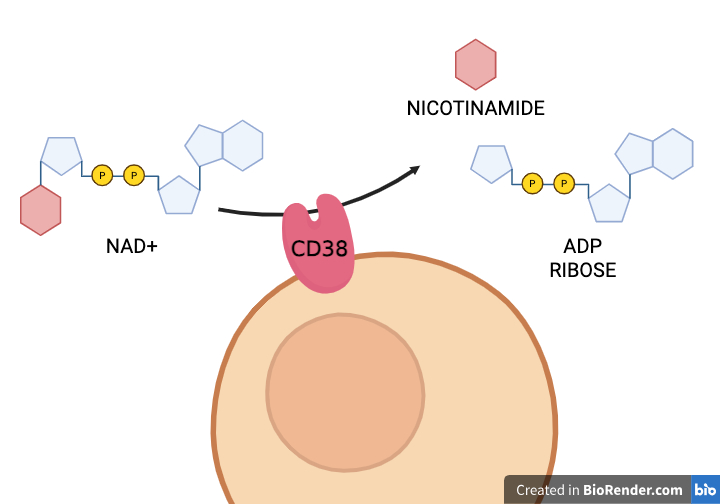Key Points:
- Dr. Verdin explains not to give up on the NAD+ and sirtuin field just because it is linked to controversy and commercialization.
- Dr. Verdin says it is relatively safe to take 250 mg each of both NMN (nicotinamide mononucleotide) and NR (nicotinamide riboside).
- In Dr. Verdin’s opinion, intravenous (IV) NAD+ is not worth the money.
In episode #359 of The Peter Attia Drive podcast, Dr. Peter Attia has a conversation with Dr. Eric Verdin, the CEO and President of the Buck Institute for Research on Aging. They discuss several topics, including the role of NAD+ in aging, which will be the focus of this article.
Beginning their discussion on NAD+, Dr. Attia outlines three facts:
- “NAD+ is completely ubiquitous throughout the body, and it is absolutely essential for the most important chemical reactions that happen in the body…
- A class of proteins called sirtuins rely heavily on NAD+ as the substrate in the process of repairing DNA.
- As you age, NAD levels decline precipitously.”
Dr. Verdin agrees there is no controversy surrounding these facts, to which Attia asks, “Armed with [these] three facts, how could it be that supplementing NAD+ does not lead to a longer, better life or some health benefit?”
Verdin’s short answer is, “It depends…” It depends on the reason NAD+ levels decrease and the supplement used to remedy this decrease.
Controversy
Verdin goes on to reveal that he’s worked in the area of sirtuins for the last 25 years, and his team was the first to experiment with human sirtuins. After that, it was the likes of Matt Kaeberlein, David Sinclair, and Brian Kennedy working in Lenny Guarente’s lab at MIT that paved the way for a lot of what we know about NAD+ and sirtuins.
A Bit of Background
In recent years, doubt has been cast on the NAD+ and sirtuin field, particularly due to the actions of David Sinclair, who is now a Harvard professor. Sinclair’s team at Harvard showed that a molecule called resveratrol activates sirtuins, but this finding was not reproducible by other scientists. To make things worse, the pharmaceutical company GSK invested millions of dollars in resveratrol but had to scrap their plans due to resveratrol and its analogues failing.

The resveratrol controversy was just the beginning of Sinclair’s long history of exaggerated claims. The last hyperbolic statement he made prompted enough backlash for him to step down as president of the Academy for Health and Lifespan Research.
Back to the Discussion
Verdin told Attia that it pains him to see the NAD+ sirtuin field, so rich in data, shrouded in controversy. He emphasizes that the controversy does not mean to give up on the whole field. Any complex field under such a high degree of investigation is expected to generate disagreement and controversy, saying,
“This is the nature of science. The beauty of science is that it’s incredibly messy on the way up, but eventually things [will be] clarified. And I think, in terms of sirtuins, we’re still right in the middle of it, so there’s some complete garbage.”
Attia agrees with Verdin, saying,
“I completely agree with that. And by the way, I’m not completely dismissive. What I will say has made this field complicated is that the leading proponents of it have all opted for a commercial pathway. And therefore, they have opted not to study this in a rigorous way but to study it in a commercial way.”
Attia says the “resveratrol debacle” makes things worse and frankly states, “I remain completely convinced that resveratrol had zero benefit whatsoever. I think it is an absolutely useless molecule.” Verdin agrees, but overall encourages listeners not to completely discard NAD+ and sirtuins, as he thinks something interesting will emerge as research continues.
Importance of NAD+ in Aging
Moving on from the topic of controversy, Verdin and Attia discuss the importance of NAD+ in aging. Verdin explains that NAD+ has two big roles:
- Redox (reduction-oxidation) reactions: NAD+ participates in redox reactions, allowing over 600 enzymes to function, making it essential for metabolic efficiency, which declines with age.
- A fuel source: Additional enzymes, called NAD+ hydrolases, cleave NAD+ to function, essentially using NAD+ as fuel. These include PARPs, involved in DNA repair, and the seven sirtuins, which all have differing vital roles in cells that protect against aging. Another important NAD+ hydrolase is CD38.
NAD+ and Sirtuins
Verdin explains that each of the seven sirtuins is activated by different concentrations of NAD+. It follows that, as NAD+ levels decline with age, fewer sirtuins will be activated. Conversely, the opposite is true. For example, during fasting, NAD+ levels will increase and activate sirtuins. Essentially, Verdin says, sirtuins are like NAD+ sensors.
How NAD+ Declines with Age
Considering that restoring NAD+ levels could be beneficial, Attia asks Verdin how to do so. Verdin responds by explaining the theories behind why NAD+ levels decrease with age. He mentions a study by Eduardo Chini showing that blocking CD38 prolongs the lifespan of mice. Verdin says his team has studied CD38 as well, and if CD38 is blocked, NAD+ levels do not decline with age.

NMN and NR
In addition to cleaving NAD+, CD38 cleaves the NAD+ precursor NMN. When CD38 cleaves NAD+ or NMN, nicotinamide (yet another NAD+ precursor) is generated. Nicotinamide then goes through a process called methylation. Verdin says taking NMN increased his homocysteine levels, which can lead to cognitive decline, due to the increased methylation of nicotinamide. For this reason, Verdin stopped taking NMN. For the same reason, some individuals (like David Sinclair) have tried supplementing with trimethylglycine (TMG, aka betaine) to restore methyl levels.
Verdin goes on to say that the NAD+ precursor NR is different than NMN when it comes to the complex chemistry. Still, the problem with both NAD+ precursors is that they are going to keep feeding the pool of NAD+, which eventually will be cleaved by CD38 to generate metabolic byproducts like nicotinamide. Byproducts like cyclic ADP ribose play a role in calcium signaling, for example. It is the generation of these byproducts that Verdin worries about.
Taking NMN and NR Together
When asked if NR is superior to NMN, Verdin says no. He then says that taking both precursors together could be a bit of insurance; taking 250 mg of each to equal half a gram would be a relatively safe dose. He goes on to say that NMN and NR could be part of someone over 60’s supplement stack. However, he still warns to check for elevations in homocysteine levels. Also, he mentions that increasing NAD+ levels may increase pro-inflammatory markers. Specifically, he is referring to the pro-inflammatory molecules secreted by senescent cells called the SASP (senescence-associated secretory phenotype).
In addition to the SASP, which are thought to contribute to driving age-related diseases, Verdin also worries about studies showing that increasing NAD+ accelerates tumor growth. He says that, in people with early forms of cancer, NAD+ precursor supplementation could lead to an acceleration. Attia then tells Verdin, while he’s not very familiar with the literature, that he remembers seeing one study on tumor growth. “You know, my take on it was, I guess, if you had cancer, this might be a bad idea to take. But I didn’t find it that convincing,” said Attia.
Intravenous NAD+
When asked about IV NAD+, Verdin says he predicts NAD+ is not a molecule that exists outside of cells in the blood. NAD+ is an intracellular molecule. Considering that NAD+ is too big to enter cells, what is it doing in the body when it is injected? He mentions a study showing that NAD+ is mostly broken down into nicotinamide when it is injected. He points out that you can buy nicotinamide supplements very cheaply, whereas IV therapy can cost $700 per injection.
“My opinion is that NAD+ intravenously is not something that should be done,” Verdin says. He does, however, say that he has heard of anecdotal evidence of dramatic effects in improving motor performance in some patients with severe Parkinson’s disease. This could be due to an increase in dopamine levels within the brain.
Best Bet for Boosting NAD+
Based on the conversation between Dr. Verdin and Dr. Attia, who is a practicing physician specializing in longevity, it would seem that the least reasonable way to boost NAD+ is intravenously. Instead of NAD+ injections, one could take a nicotinamide supplement. While not discussed, nicotinamide may provide similar benefits to NMN and NR. However, there is a lack of studies directly comparing the efficacy of nicotinamide, NMN, and NR. With that being said, Verdin seems to think that taking both NMN and NR could be the best bet. Interestingly, Stanford scientist Andrew Huberman, PhD, has gone on record with saying he was taking both NMN and NR. Still, there is a lack of studies testing the effects of both NAD+ precursors together.